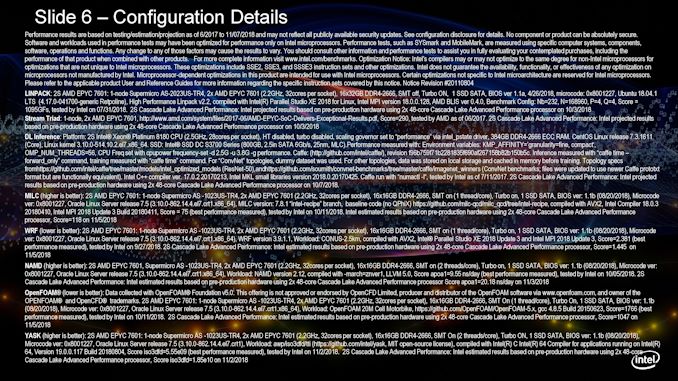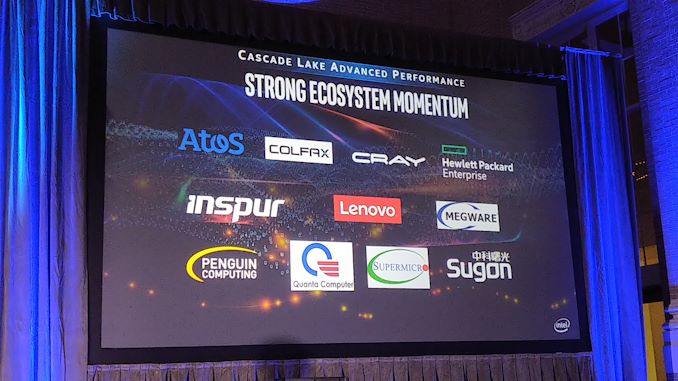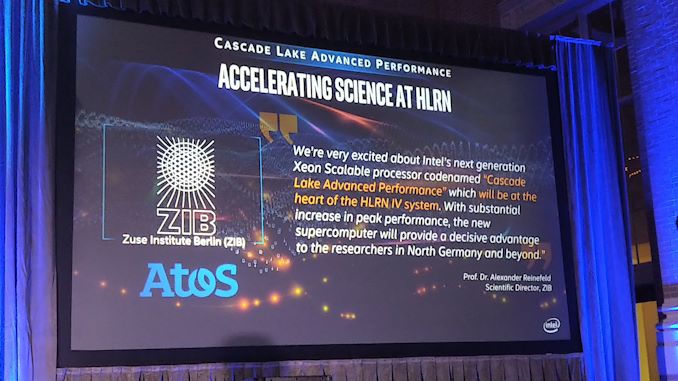Intel Offers More Cascade Lake-AP Performance Numbers
by Ian Cutress on November 11, 2018 6:15 PM EST- Posted in
- Enterprise
- Intel
- HPC
- Enterprise CPUs
- Cascade-AP

One of the announcements from last week involved Intel and its new Cascade Lake Advanced Performance category of processors to launch next year. These new processors will be based on combining two 24-core Cascade Lake-SP processors on a single package substrate to offer a single socket 48-core option with a total of twelve memory channels. The Cascade Lake-AP parts are going to be launched next year, and until then Intel is putting out some internal benchmark numbers.
Vendor Benchmark Results
When we are this far away from a product launch, all benchmark numbers should be taken with a grain of salt. This goes doubly so for vendor supplied benchmarks. However, Intel is on the warpath to promote what it sees as a new product family within its portfolio, even if it is only set to come out next year.
At the announcement last week, Intel offered Linpack and Stream Triad as two main high-performance metrics as comparison. Today Intel is also offering more ‘real world’ metrics. These metrics are, to quote Intel, ‘estimates based on pre-production hardware’. This means that the hardware is not ready yet, and these are values based on the engineering samples running but extrapolated to an expected benchmark value. Add another dump truck of salt on these numbers.
Intel’s official list of results are as follows:
| Intel's Benchmark Numbers for 2S 48 Core Cascade Lake-AP |
||
| Benchmark Type | Score vs 2S EPYC 7601 | |
| *These numbers were created by Intel | ||
| Linpack | Numerical Linear Algebra | 3.4x |
| Stream Triad | Memory Bandwidth | 1.3x |
| MILC | Quantum Chromodynamics | 1.5x |
| WRF | Weather Forcasting | 1.6x |
| OpenFOAM | Computational Fluid Dynamics | 1.6x |
| NAMD (APOA1) | Molecular Dynamics | 2.1x |
| YASK (ISO 3DFD) | HPC Kernel Tuning | 3.1x |
The slide with this data is in the gallery below.
In each case, Intel is comparing a dual-socket Cascade Lake-AP system with a dual socket EPYC 7601 system. Intel’s information slides go through how it set up all of its AMD systems in detail, however it does not disclose how the Cascade Lake-AP systems are set up by comparison, presumably as to not disclose any additional set-up numbers.
For the most part, we don’t put much stock into vendor supplied benchmark numbers. It’s easy for a vendor to claim a multiple when doubling particular compute resources, but when it comes to real world tests, companies like Intel have to try and promote its future products to potential customers. This is what this is. However, no matter how many numbers come out, these are impossible to verify independently. Wait until the AnandTech review, of course.
Intel also disclosed a number of ecosystem partners who are getting ready to deploy Cascade Lake-AP, as well as an offical declaration of the Cascade Lake-AP deployment at HLRN.
Cascade Lake-AP is set to be launched alongside the Cascade Lake-SP in the first part of 2019, although Intel states that Cascade Lake-SP will ship for revenue in 2018. This week we are at the Supercomputing trade show - hopefully there will be a demo somewhere that we’ll be able to see and talk about.



















52 Comments
View All Comments
yeeeeman - Monday, November 12, 2018 - link
So lets put these benchmarks into context. They compare a 48 core CPU with a 64 core system made from 2 CPUs each 32 cores each. Fair enough, they do manage to get better results with lesser cores, but I am pretty confident that these are scenarios where inter-CPU communications matter and we all know that the latency is high on a dual socket system.Second, AMD has their new CPU line-up just around the corner and they double pretty much everything. They also quadruple FP resources.
If things go well, then it could very be that one Rome CPU could keep up with 2S Cascale Lake AP system, which would be disastrous for Intel.
GruenSein - Monday, November 12, 2018 - link
If I understand correctly, the figures refer to a system with two sockets each occupied by a 48 Core Cascade Lake AP. That means that they get 1.5-1.6x the performance with 1.5x the number of cores of Epyc 7601 in most scenarios and maintain a performance lead on some hyper-optimized AVX-workloads. And this is comparing an unreleased system to AMD's line of processors, which have been available for a year or so. No power figures are provided and only few benchmarks are shown. I think, it is safe to say that Zen 2 will be much faster based on the number of cores alone. That is not even considering the expected improvements in IPC, clocks, and power efficiency.yeeeeman - Monday, November 12, 2018 - link
Then they are doomedFitzgeraldH - Monday, November 12, 2018 - link
Gruensein is indeed correct. Slide 6 states 2x48 cores Cascade Lake (it's the last sentence in each paragraph).Spunjji - Monday, November 12, 2018 - link
Solid summary. +1rahvin - Monday, November 12, 2018 - link
Intel disabled SMT on the Epyc chip in their "benchmarks". You should keep that mind. They probably did this because their own chip won't have hyper-threading, anything you can do to show your own processor in the best light.The test on how scared intel is will be what they do with prices. If they drop prices where they've planned to raise them 20% we'll be seeing AMD taking more of the cloud operators.
lordtux - Monday, November 12, 2018 - link
Well, on the footnotes is showing 2x48c against a 2x32c, so its 96c against 64c. Seems that everyone is thinking that one CPU of 48c is beating a 64c. This turn the things worst for Intel.schujj07 - Monday, November 12, 2018 - link
They also didn't say whether SMT was enabled on the Intel system or not. On several of the benchmarks SMT was disabled on the Epyc and then enabled on other benchmarks, however, no mention of what it is for Intel.Rukur - Monday, November 12, 2018 - link
It's a rainbow unicorn CPU. Where is my 5GHz 28 core workstation and abomination of a motherboard Intel ?.vodka - Monday, November 12, 2018 - link
Shortly after the public demo, the one and only sample that could do 5GHz on all 28 cores crashed and burned.